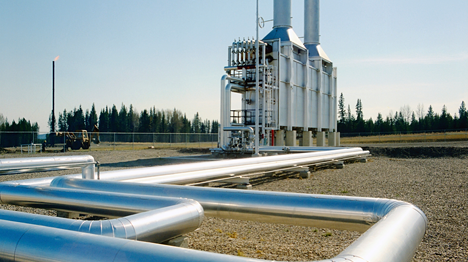Natural gas

Natural gas is the most important gaseous fuel for industrial applications. Many major population centers worldwide have a closely knit and constantly growing natural gas network. This makes it possible to distribute large quantities of gas with highly reliable supply. To avoid the considerable costs of long pipelines, natural gas is more and more frequently liquefied (LNG: Liquefied Natural Gas). Then it can be stored in tanks and transported in ships. Transport on LNG tankers has increased sharply. Compared to long-distance gas pipelines, they have the potential of supplying regions without natural gas deposits with this fuel cheaply as well.
In addition to conventional natural gas, natural gas from sandstone, slate and coal seams is gaining in importance. Because the technological overhead for extracting it is considerably higher, however, "non-conventional natural gas" currently accounts for only a small portion of overall quantities in Europe.
Operators of a natural gas combustion system benefit from numerous advantages: The price is often cheaper compared to oil and tank plant isn’t necessary. Furthermore, combustion of natural gas is particularly clean and free of residue. Emission values are normally well below a comparable oil combustion system. The control range of a gas combustion system is often larger, which makes heat supply flexible and saves resources if burners frequently have to be operated at low firing rates. Moreover, compared to coal and oil, natural gas is the "most climate-friendly" fossil fuel because significantly less CO2 is produced when it combusts. Excellent burner solutions with highly efficient firing can be implemented with natural gas due to its low sulfur content.
The only disadvantage of this heat source is dependence on the natural gas supplier and suppliers' prices. In this case dual-fuel burners are an attractive alternative to provide maximum independence even in fluctuating heat markets.
Some facts about natural gas
Natural gas is a combustible mixture of various hydrocarbon compounds with methane as the main ingredient. It can be either selectively extracted or may occur as a by-product of petroleum extraction and is categorized according to the heat value and extraction area. The term "natural gas L" is used if the calorific value Hs (previously the upper heat value) is less than 36 MJ/m³ (at STP). Above this limit the gas is referred to as "natural gas H". Because of the differing heat values, natural gas consumption is frequently expressed in kW/h instead of cubic meters.
The type of natural gas with a lower heat value, L, consists of 85% methane, 4% other alkanes (ethane, propane, butane and pentane) as well as 11% inert gases. Natural gas H from deposits in the North Sea contains about 89% methane, 8% other alkanes and 3% inert gases. Russian natural gas H consists 98% of methane and contains 1% each of other alkanes and inert gases.
All types of natural gases are lighter than air: its relative density in comparison to air is about 0.6. Odorous substances are added to natural gas to detect leaks quickly in a pipeline network. Depending on the type, between 8.4 and 9.5 m³ of air is required for the stoichiometric combustion of one cubic meter of natural gas.
Combustion of natural gas is nevertheless possible within a wide range of mixing conditions. The ignition limit for natural gas L is between 5 and 15% by vol., for natural gas H between 4 and 16% by vol. If firing is optimally adjusted, natural gas combusts almost completely to form carbon dioxide and water. The dew point of wet flue gas in this case is about 58°C.